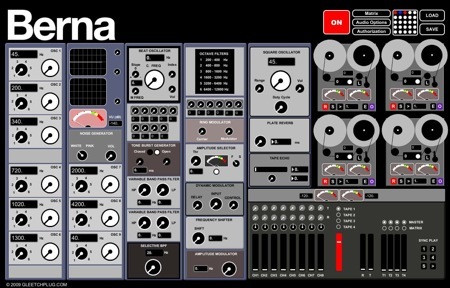
There’s an early review of Berna – the virtual studio app that recreates a 50’s electronic music lab – at Waveformless.
They say there’s a lot to like in Berna:
The flexibility of the matrix and the vast array of unusual sound manipulators will be a breath of fresh air to those burned out on the virtual analog trance machines that seem to get released every week. The limitations present here are faithful to what the original studios were limited to, and sometimes having those kinds of restrictions can lead you down very interesting paths you might not otherwise travel.
For sure, this isn’t the most useful piece of software in the world (to most of us), but it’s really hard to find fault anywhere with the program. The sound quality is great, the tools are weird and fun to play with (it drove my cats NUTS), and you can learn a bit about the history of your craft in the process. If nothing else, it’ll certainly give you an appreciation for how easy modern electronic composers have it.
So if you’d like a break from the norm and feel up to making some crazy 1950’s sci-fi soundtrack fodder, it’s hard to go wrong for a mere 10 Euros. [9/10]
See the full review at Waveformless.

Until payday I'll explore the demo version (stops after 4 minutes) and was reading the manual on the train earlier as it's not the kind of programme I can simply play around with without knowing the operational basics. But I totally love the idea of it. And the manual itself warms me to the whole enterprise, with its friendly but scholarly tone. In fact, it's in an elite group of manuals that are a pleasure to read in their own rights. Bravo!! =D
Of particular interest to me – without even having learned to operate it yet – Berna clarifies my understanding of my existing DAW (Logic Studio). 'Traditionally' the concept model for the DAW is that of the recording studio, which is populated with instruments, processors, a mixing desk and a recorder. The problem with this conceptual model – for me – is that it leaves me feeling rather exhausted, as if I had to do the jobs of several different specialists simultaneously and in real time. This corresponds to a feeling of pressure, even panic. I'm also troubled by the aesthetic notion of the DAW as a sort of 'fake' version of a 'real' studio; a problem many others have with the concept of the synthesizer plug-in. However, seeing into the detail of Berna, I notice that the early electronic studio was, in a sense, an early synthesizer. What this allows me to do is to imagine less of 'now I'm a composer' then 'now I'm a musician' then 'now I'm an engineer' and 'now I'm a producer' and more of 'now I'm a musician, and this DAW is my instrument'. Thus, my plug-ins aren't so much independent instruments – like a violin or a piano or a keyboard synthesizer – so much as components within an instrument; as strings and soundbox and bridge are to a violin. In this sense, signal processors don't happen after the event of performing. Instead, they are an integral part of the sonic performance. As is the balance of volumes and the stereo picture. The workflow diagram isn't a one-way street but rather a spatial matrix. The sense of performance time isn't a single episode but a recursive effort much like a sculptor gradually hones away at a lump of marble or a painter gradually layers-up the composition and colour-field. In its relative simplicity and intention, the early electronic music studio allows me to think of the variables in the province of the individual and in the space of patient experiment. This is a fundamentally different approach to that of the acoustic or electric group performance 'caught on tape'. In this, the single artist gradually shapes the layers and correspondences of an electronic data-field or, perhaps I should say, data-garden…
http://www.myspace.com/p8b50
http://www.myspace.com/p8b50